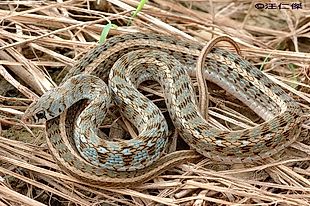Amphiesma stolatum
Buff Striped Keelback
花 浪蛇 (hua1lang4she2)
Status: Not Protected
Non-venomous
Videos
Family
Colubridae, subfamily Natricinae
Max. length
90 cm
Occurrence in Taiwan
Throughout Taiwan, Matsu, and Orchid Island, up to 500 m altitude.
Global Distribution
Taiwan, South China (Anhui, Guangdong, Guangxi, Guizhou, Henan, Hunan, Yunnan, Zhejiang, Hainan, Fujian, Jiangxi), Sri Lanka, India (Maharashtra, Arunachal Pradesh), Myanmar, Thailand, Vietnam, Laos, Cambodia, Nepal, Pakistan.
Description
Small snake; total length up to 90 cm. There are 17-19 rows of scales, which are
strongly keeled except, except those on the flanks. Head is elongate oval
to slightly triangular; body is slender; tail is long. Eye is medium to
large; iris is dappled yellow and black, with outer part of eye black and
blending into yellow around pupil; pupil is round, jet black, surrounded
by narrow band of light to medium yellow. The supraocular is moderately
well developed forming a ridge above and a short distance anterior to eye.
Tongue has black stem and gray fork tips. Upper head is gray or medium to
olive brown with usually prominent upper shields due to black borders.
There is a cream or yellow area, adjourning to a black vertical line,
anterior to and posterior to eye. The lighter supralabials are well marked
with black along sutures or on posterior margin of each scale. Two yellow
or buff stripes extend along the sides of the gray, brownish or
olive-green upper body, which is crossed by blackish bars. The stripes are
usually diffuse at neck and especially bright on the second half of body.
Near the neck, the crossbars are prominent whereas on the second half of
body they may become diffuse. The ventral head is cream to bright yellow
while the ventral surface of neck region is yellow. The ventral body
posterior to neck and ventral tail are white to light gray with black
spots or areas of scattered dark pigment on lateral quarter of the ventral
area, which appears as a faint longitudinal line near latero-ventral
junction and tends to disappear in the posterior part of body. Anal scale
is divided and subcaudals are paired.
Biology & Ecology
This terrestrial, diurnal snake inhabits well-watered lowland plains and hills.
It hunts frogs, toads, and fish, occasionally also earthworms and geckos. Females
produce 4-16 eggs of approximately 2.5x1 cm per clutch in late spring. It has a gentle
disposition and as a rule will not strike or attempt to bite: "This snake is reputed as one
of the most inoffensive of snakes. Many of its local names convey its innocent nature.
Often it is referred by the locals as the "the snake that cannot kill" in their native tongues.
This snake is diurnal by nature but may hunt at night if highly rewarding. Often frequenting near
puddles and areas where frogs take refuge but very rarely enters the water itself. Humans frequently
come in contact with this snake and in response it will dart out of danger and hide itself in neighbouring
vegetation. If captured it will make no attempt to escape and will not attack
even if viciously molested." (Source)
Etymology
Amphiesma: Greek for "garment, vestment", named in apposition to the epithet of the
type species, A. stolata, stolata itself being classic greek for garment (i.e. stole),
in allusion to the pale bands that run down each side of the back.
The Chinese name 花浪蛇 (hua1lang4she2) means "flower wave snake".
Further Info











